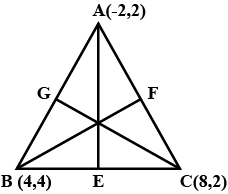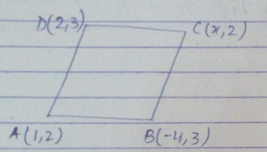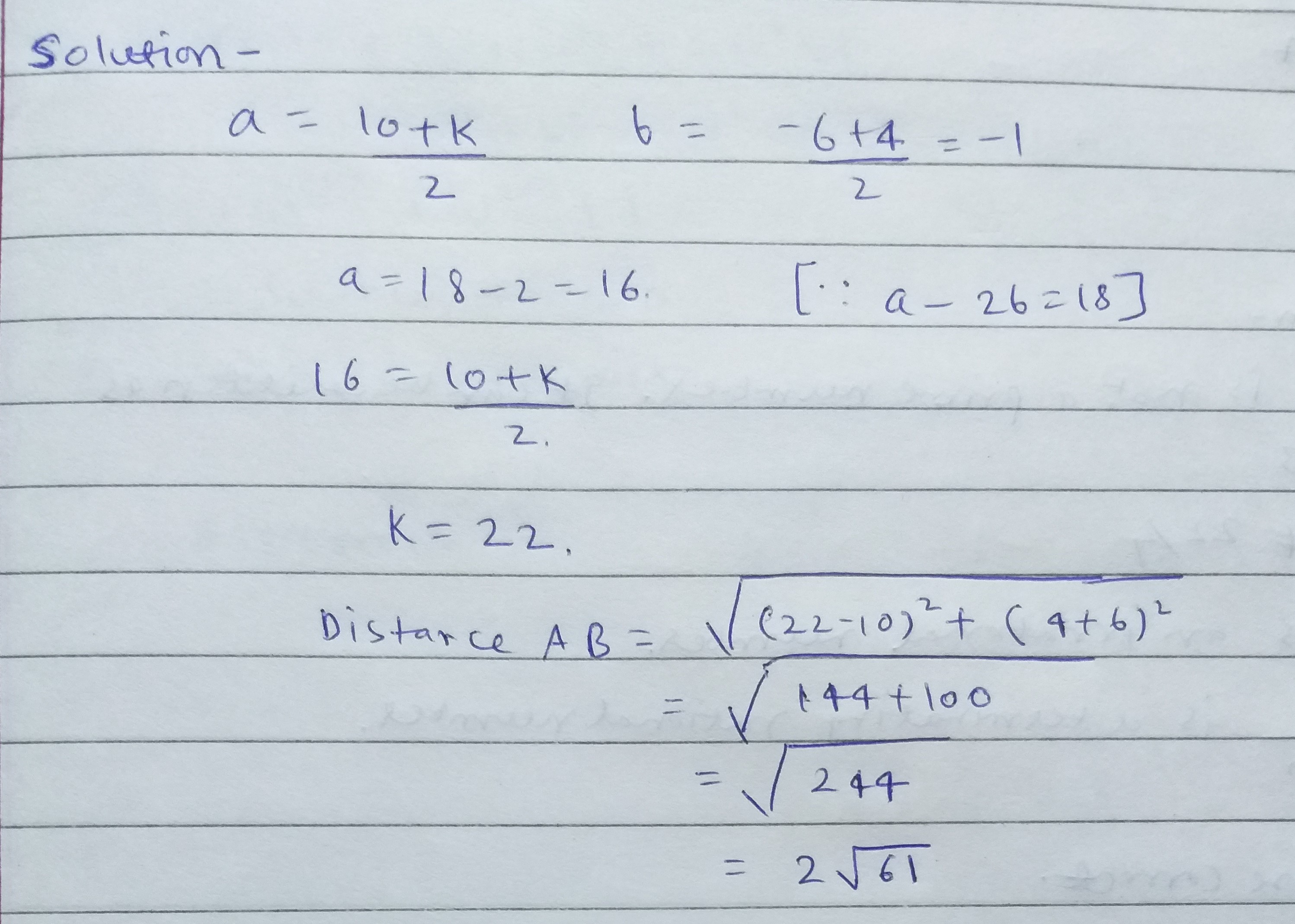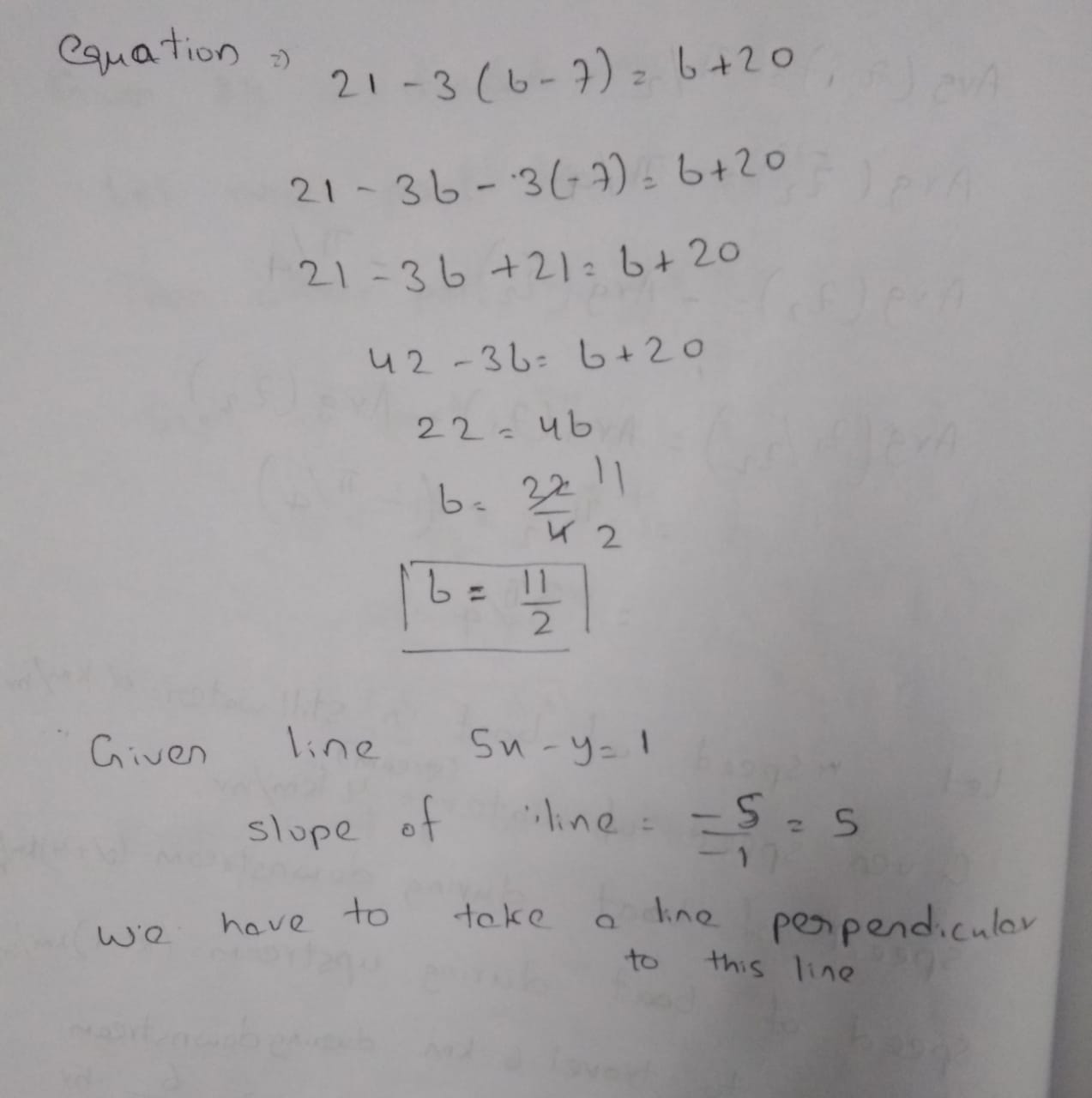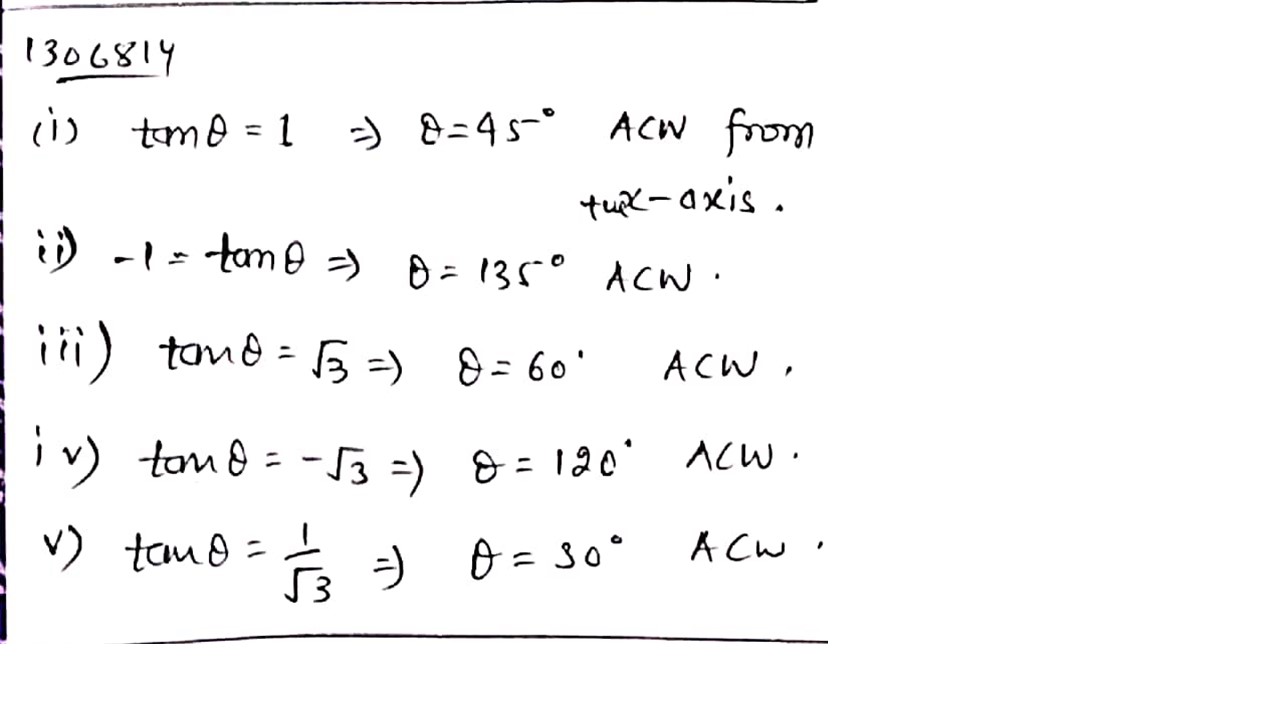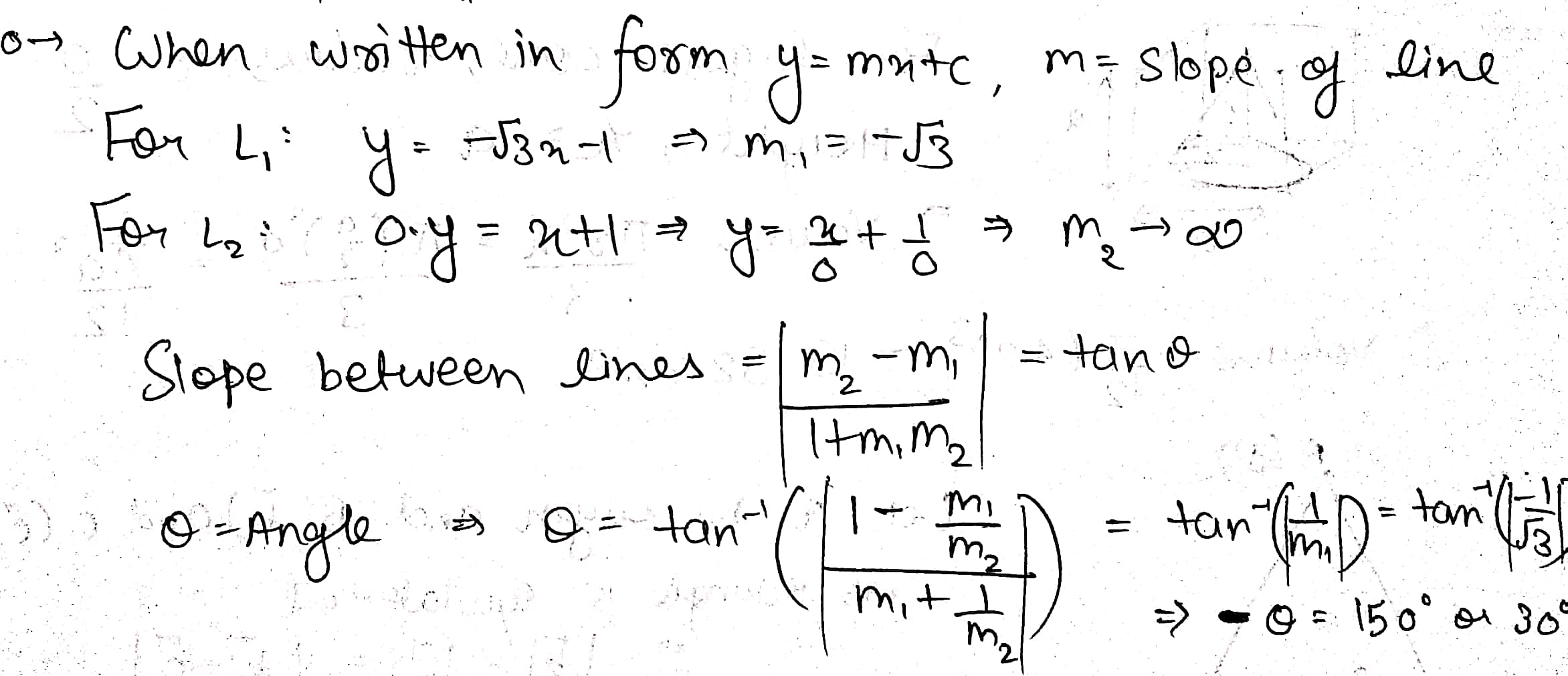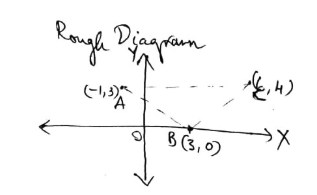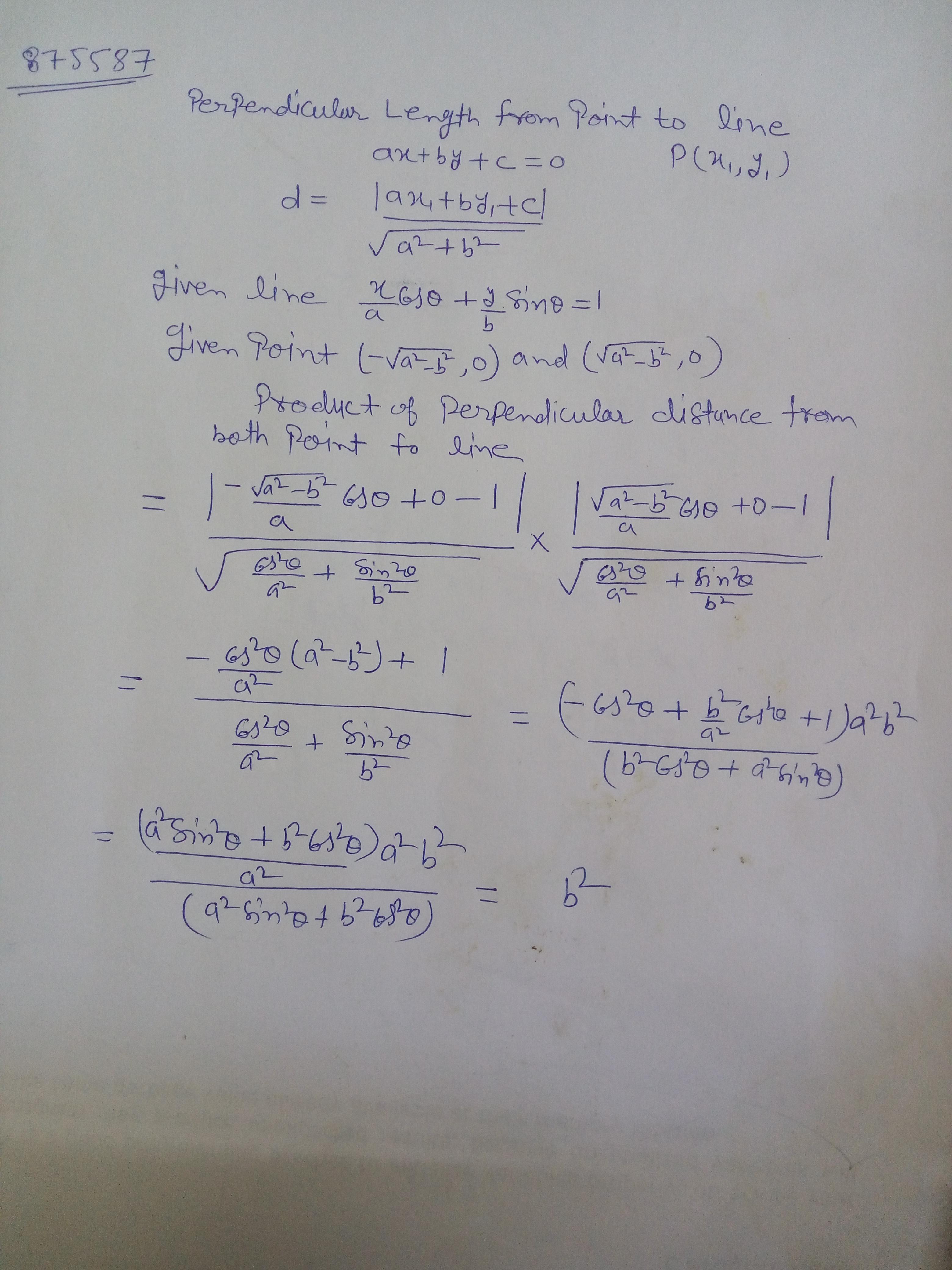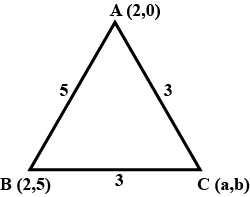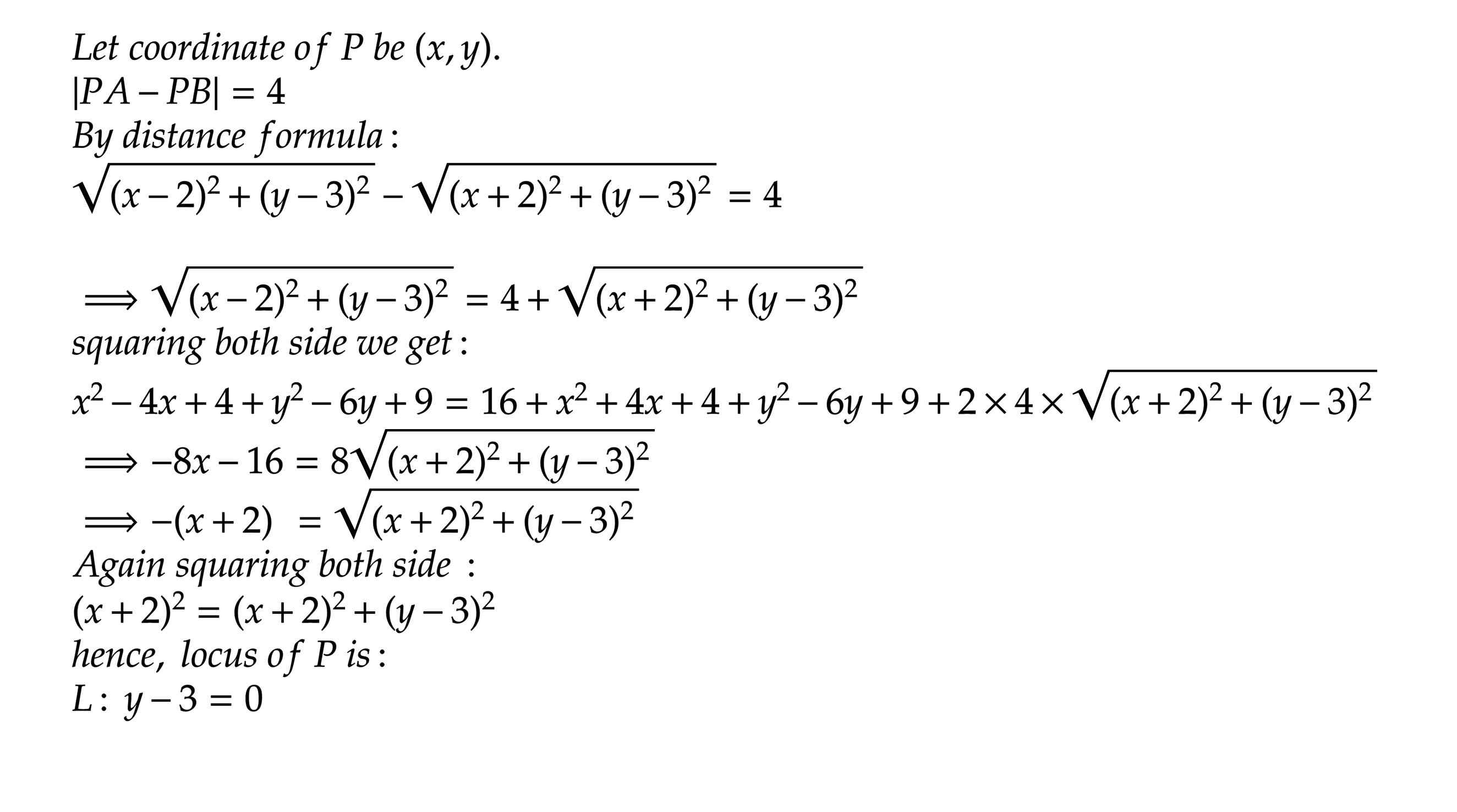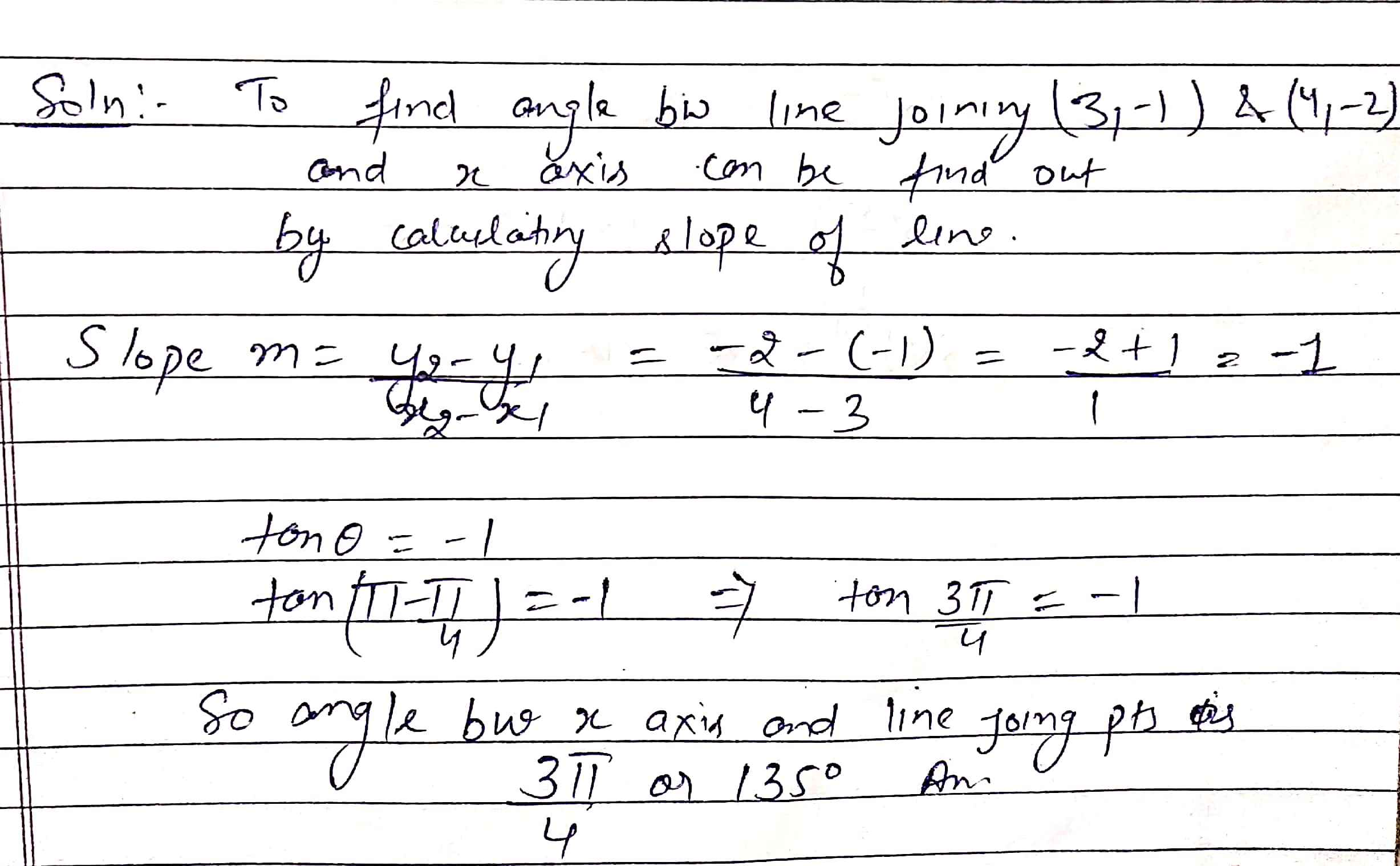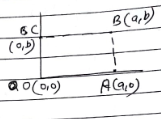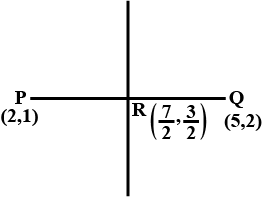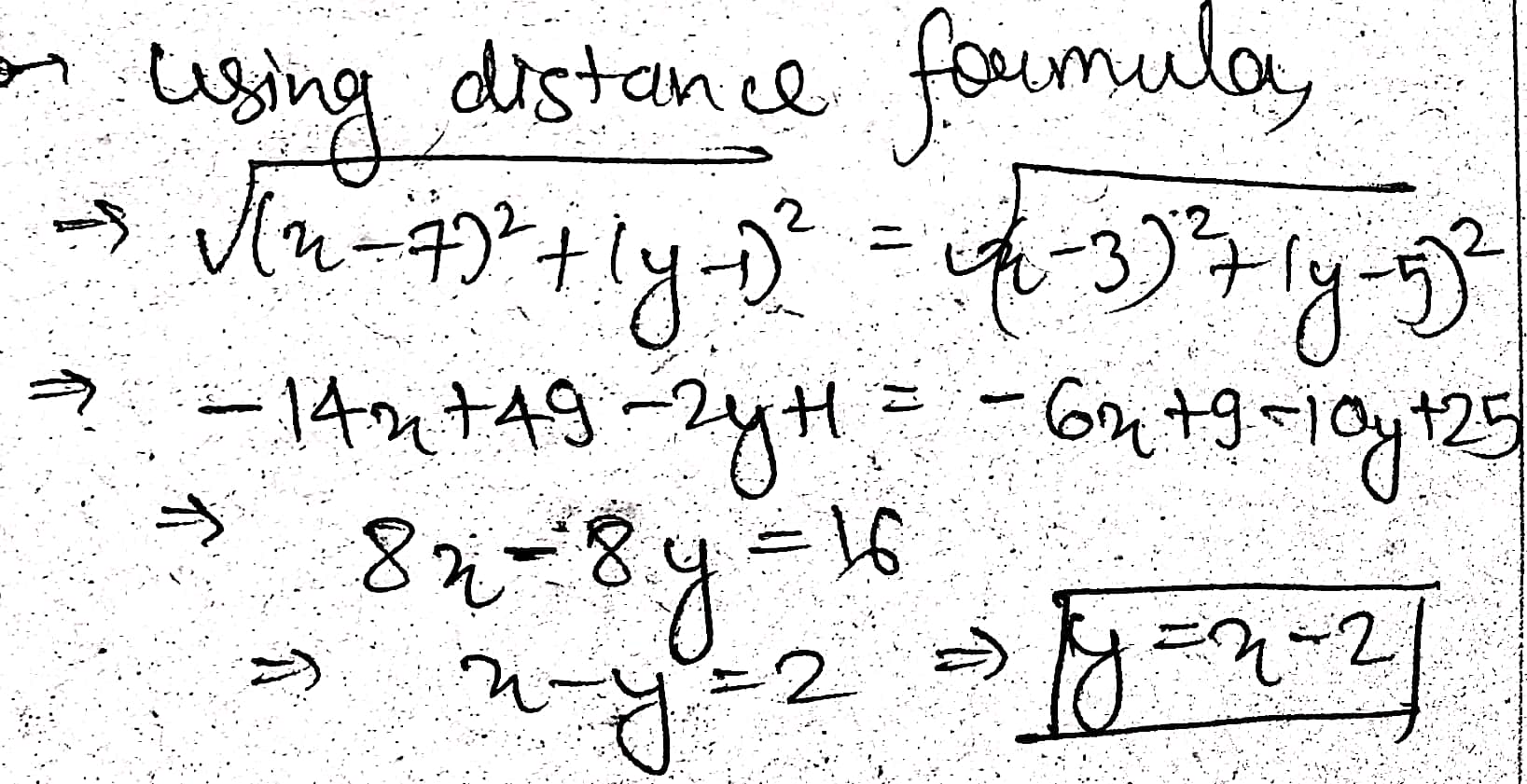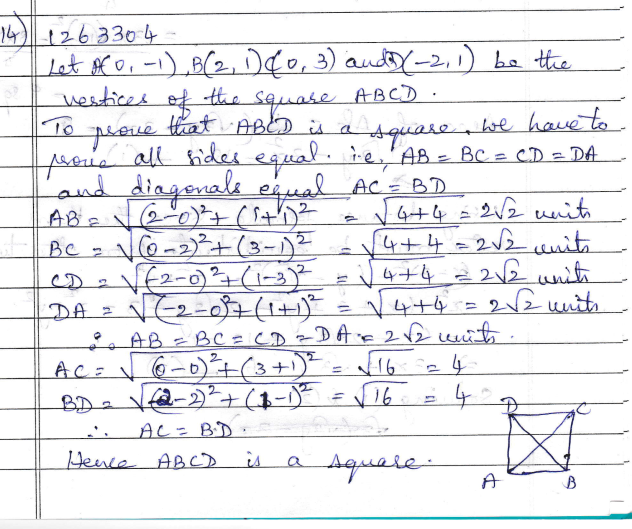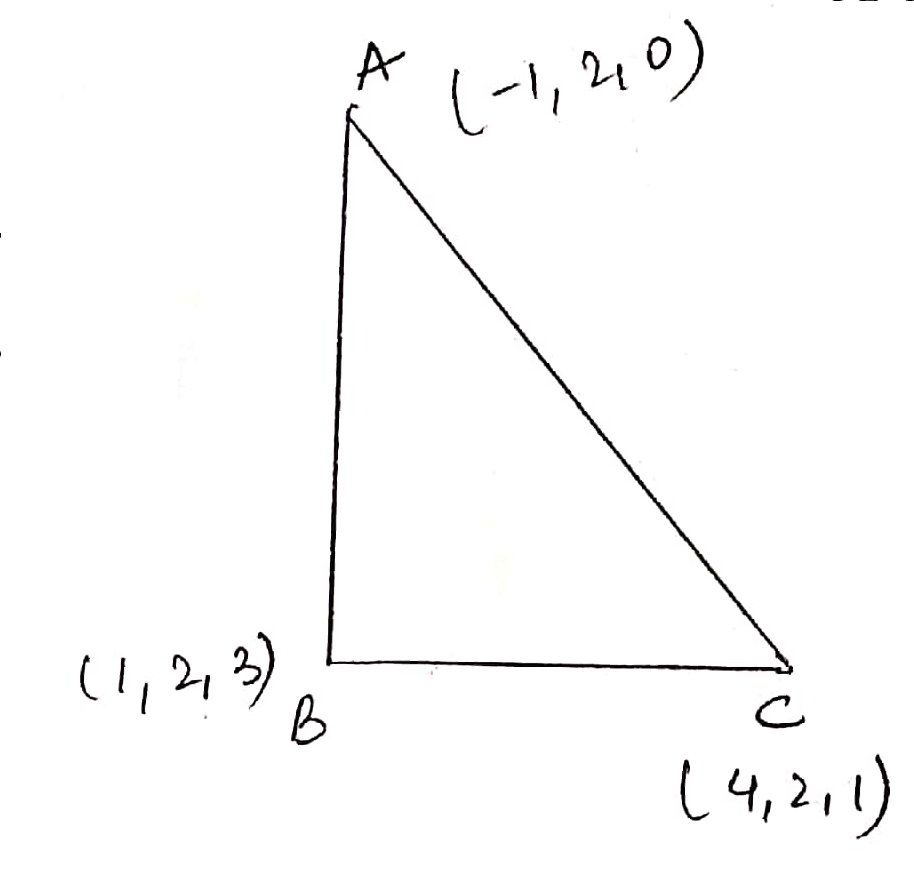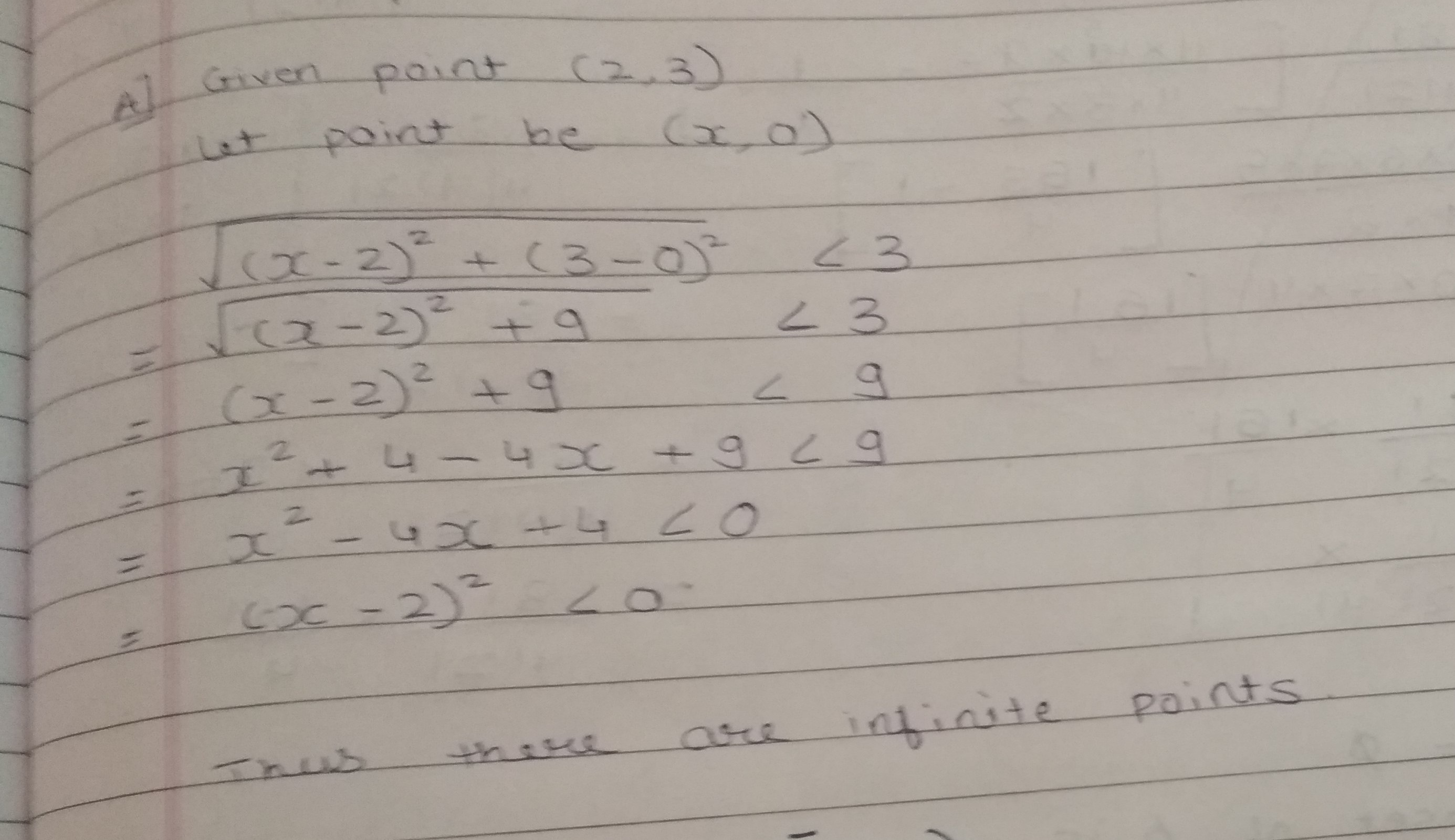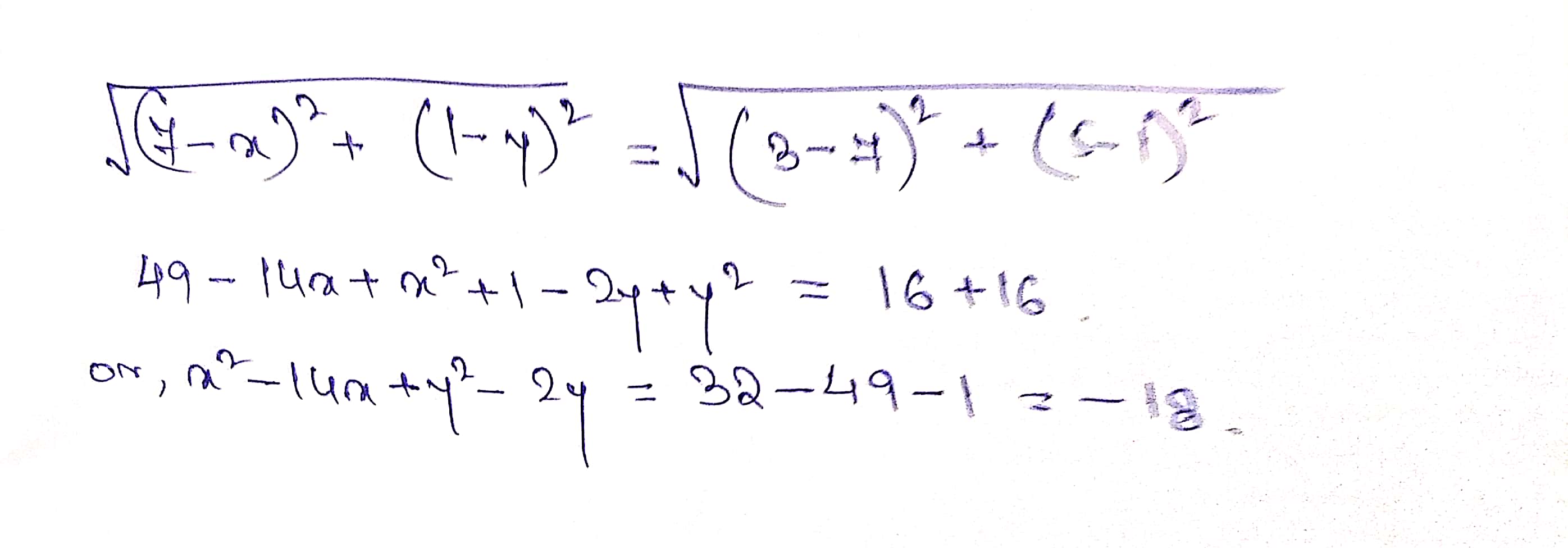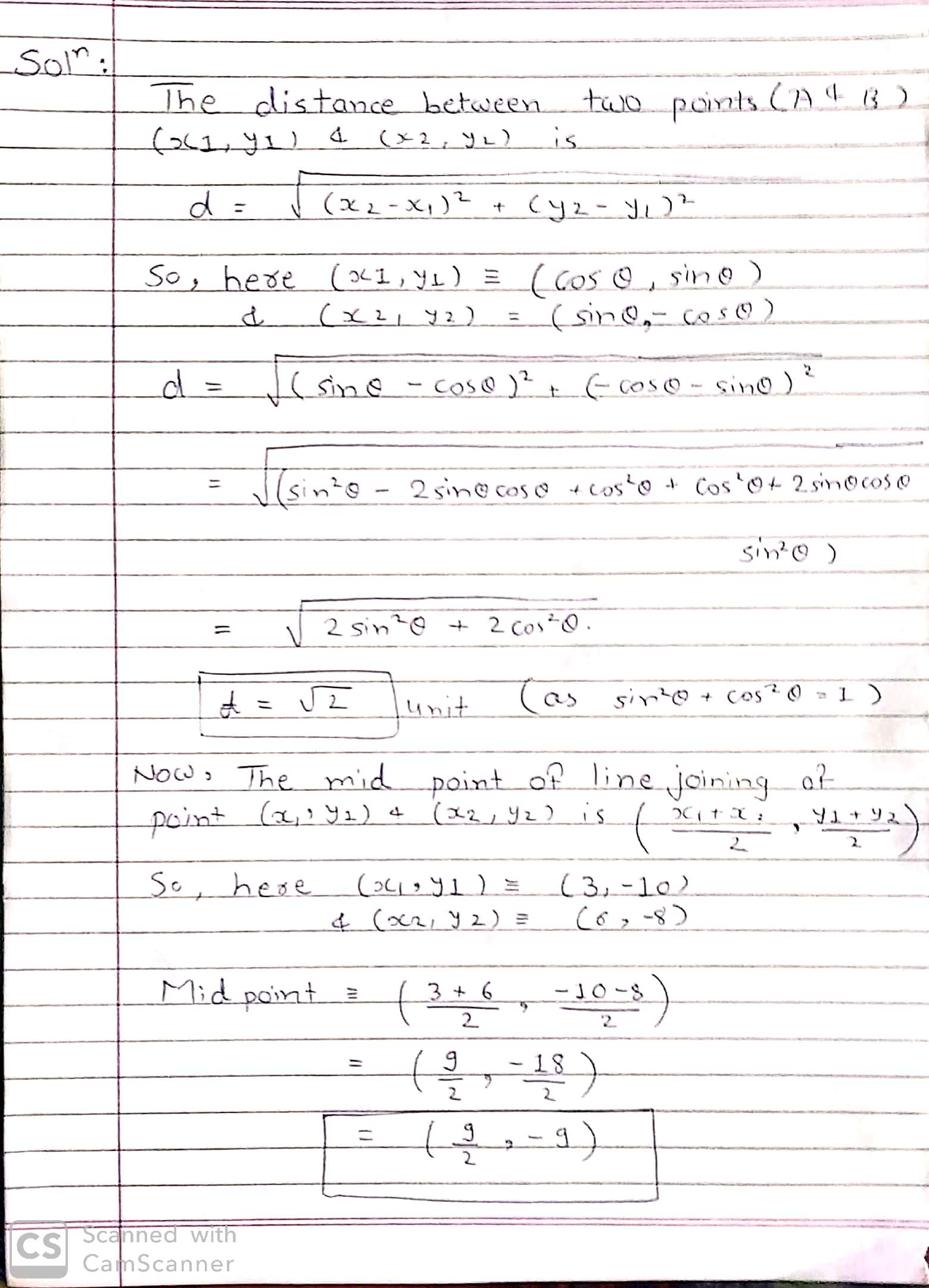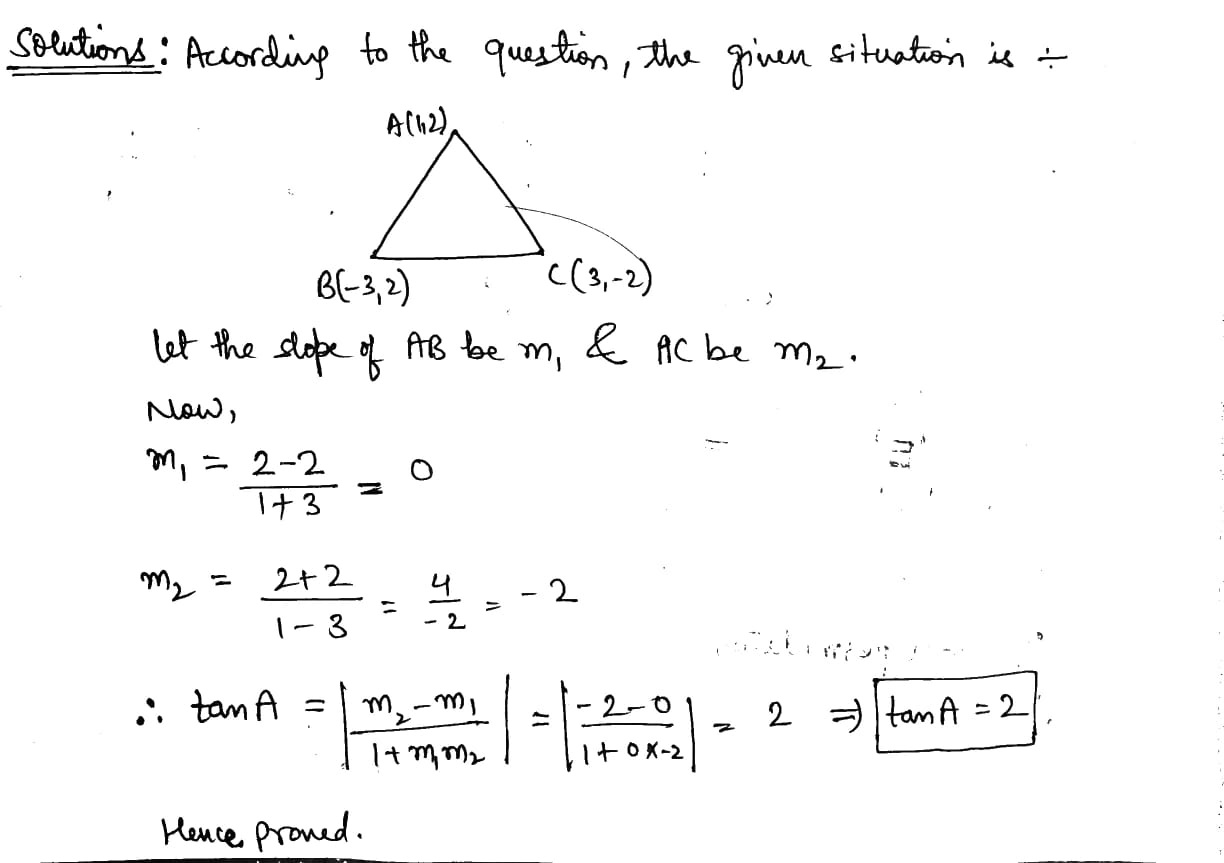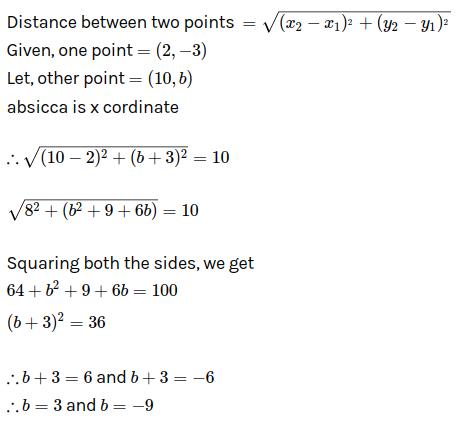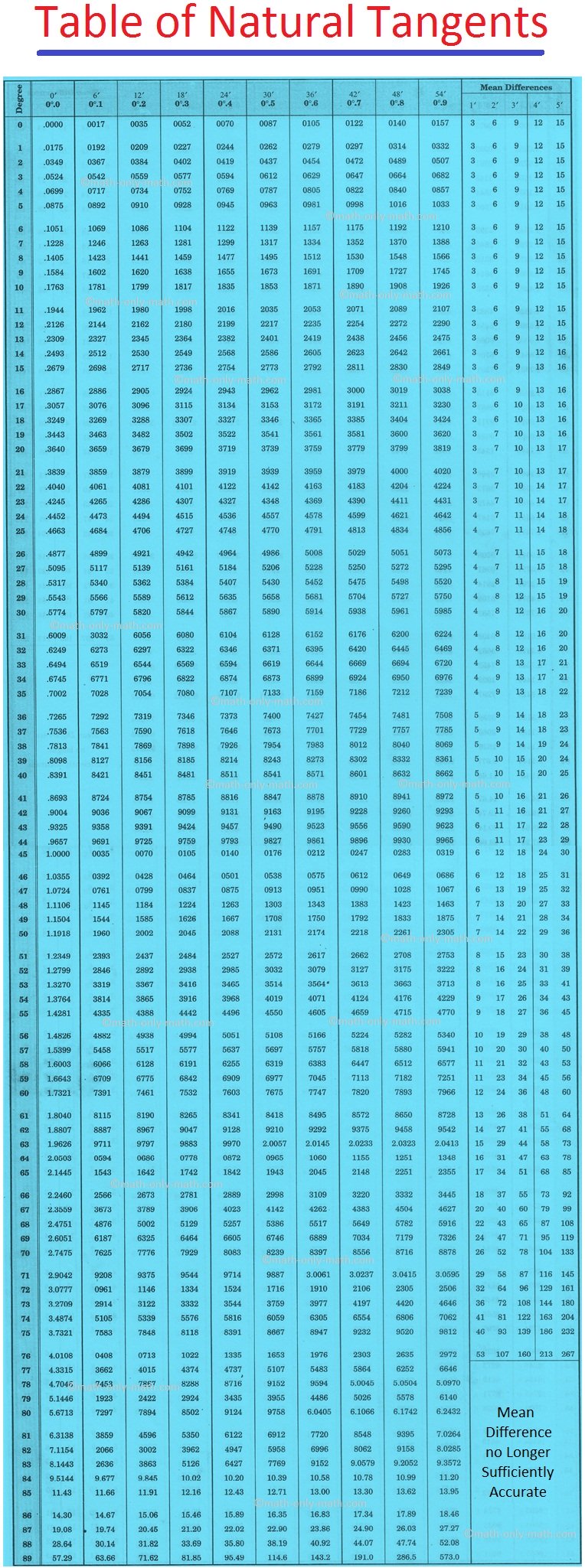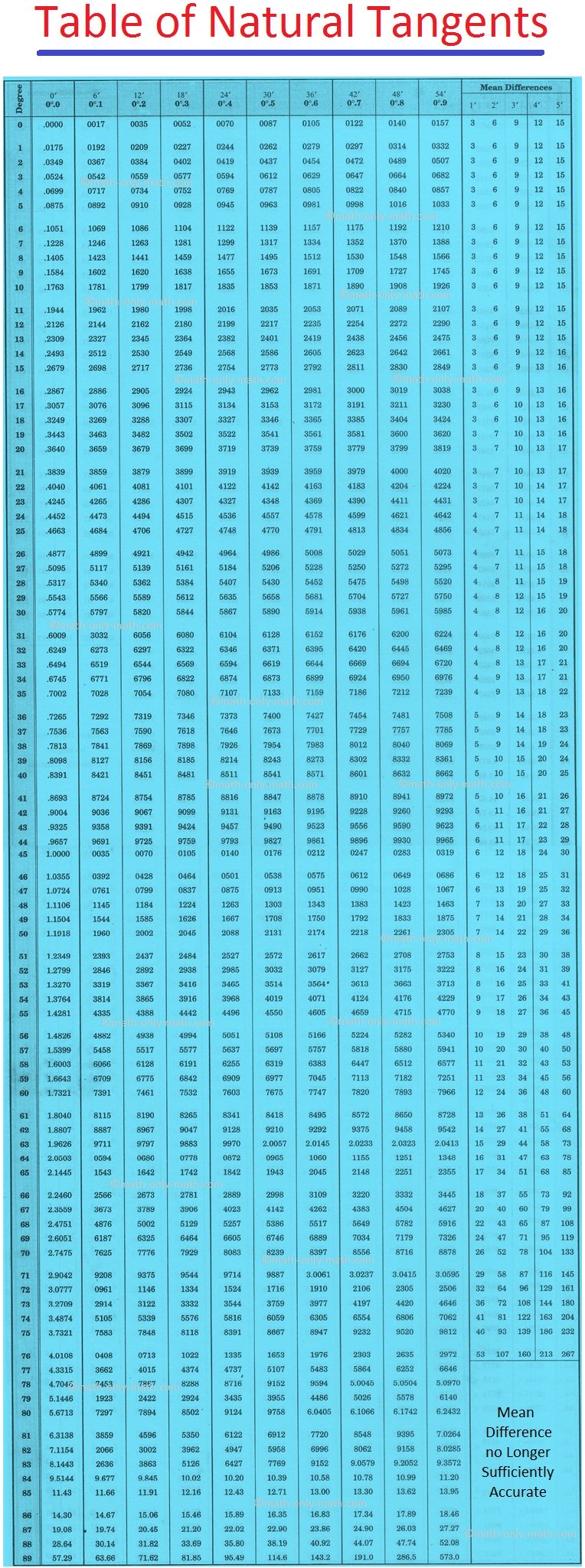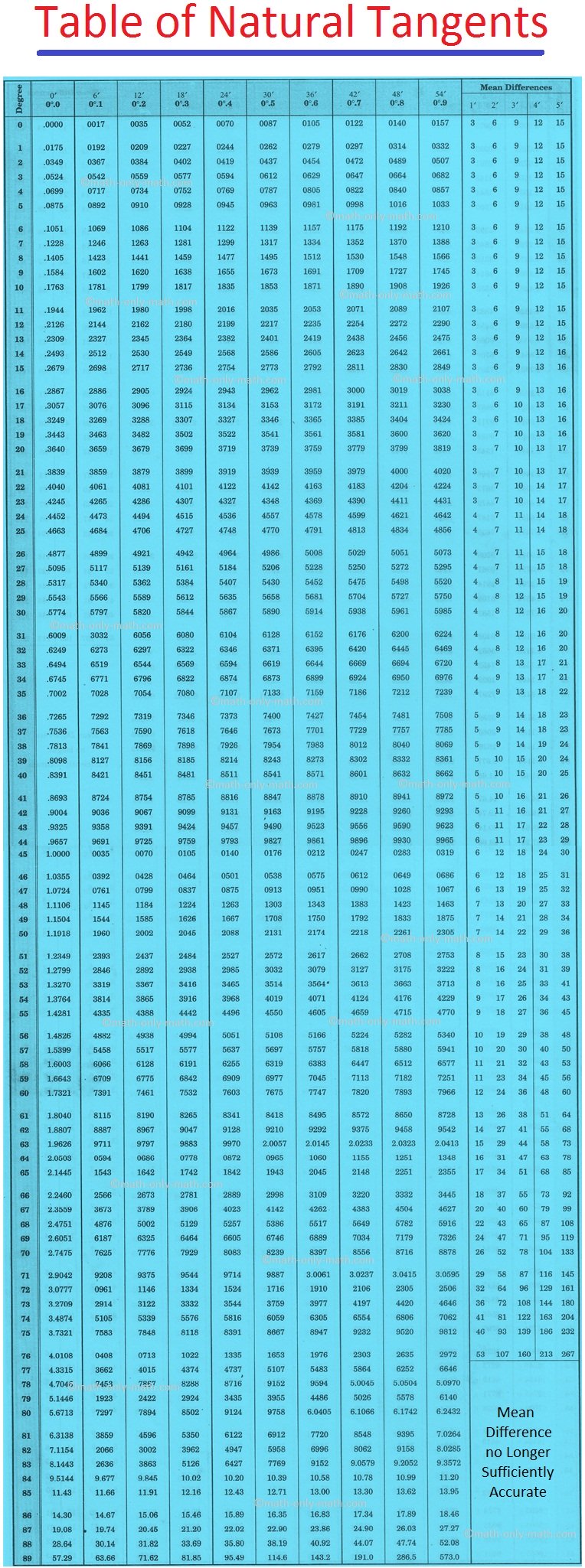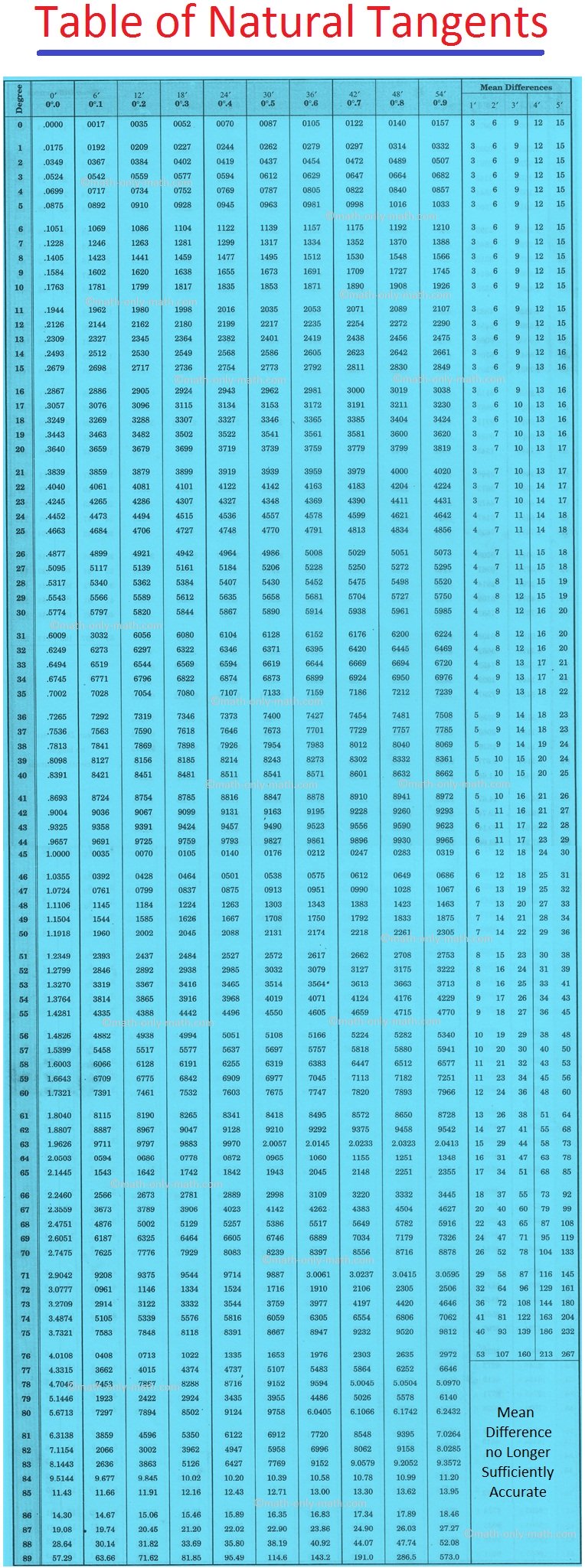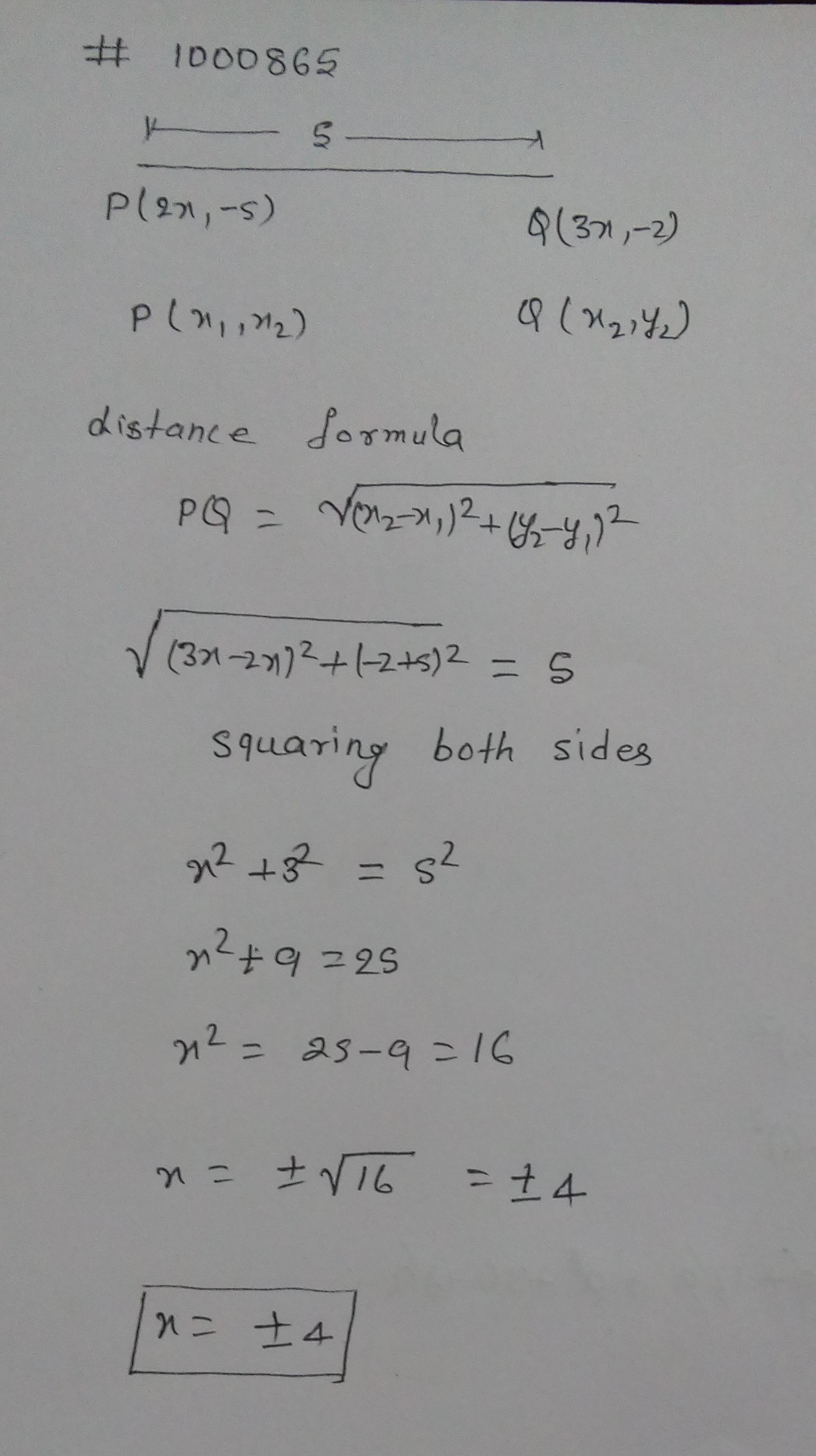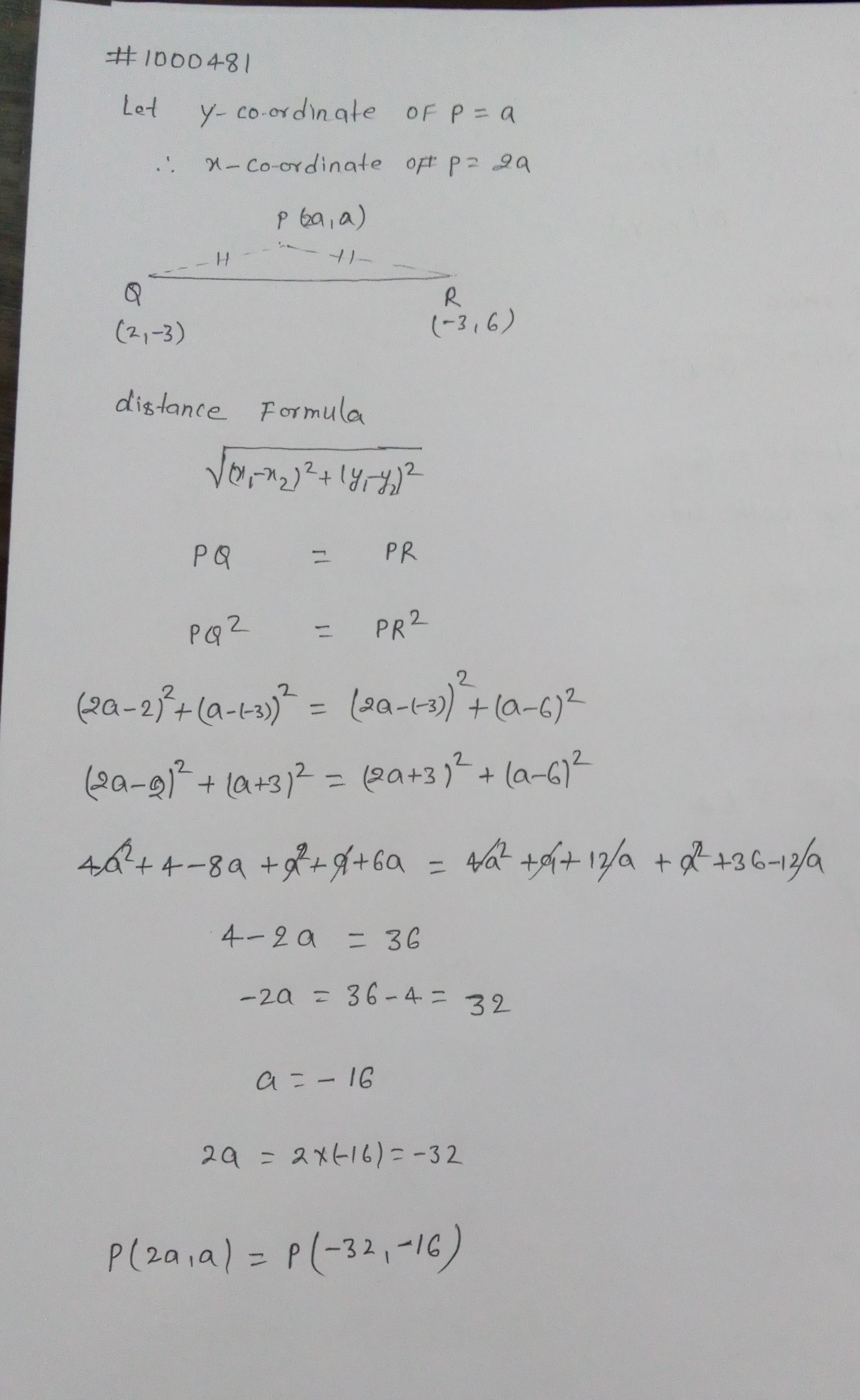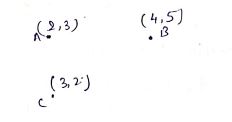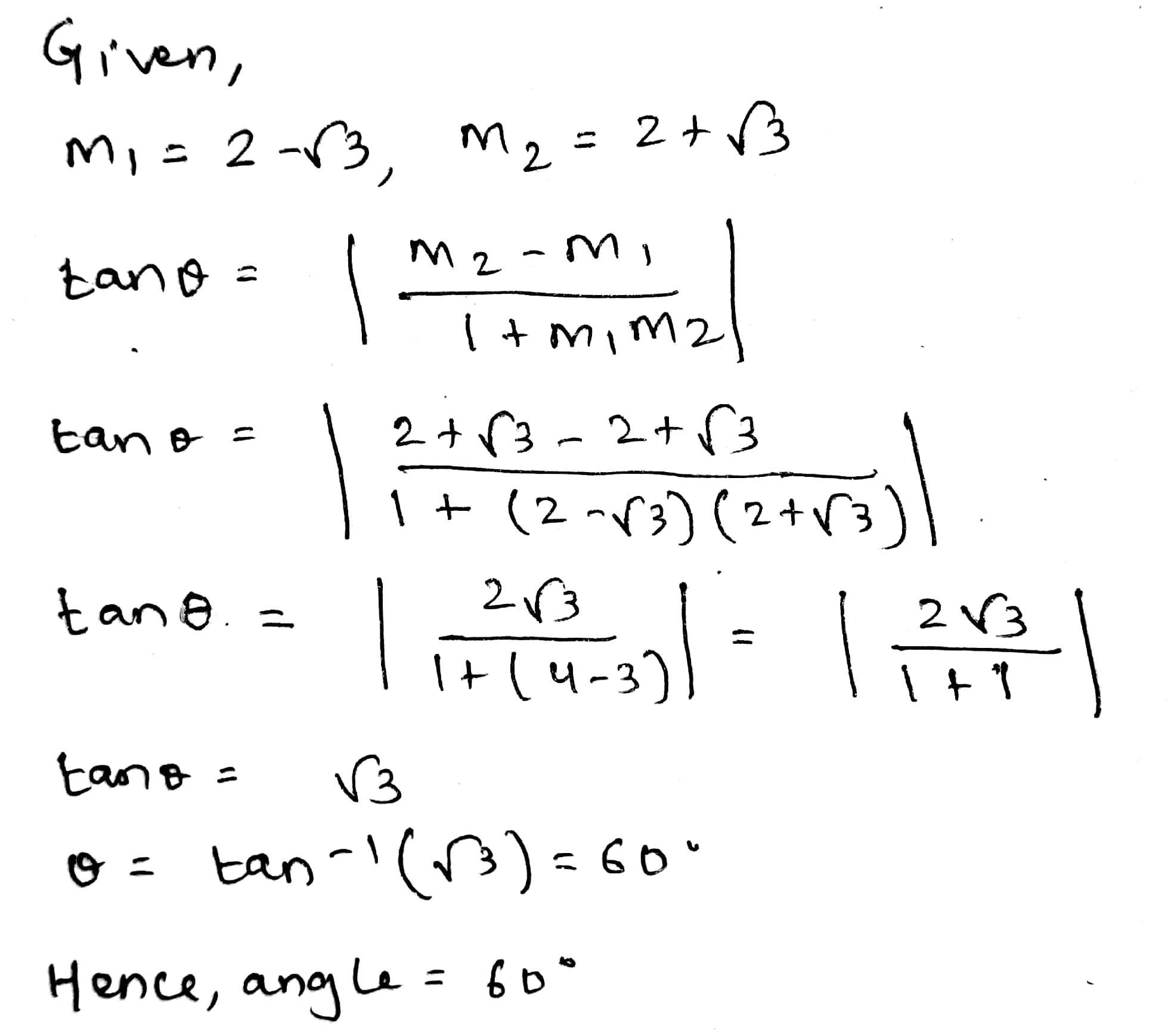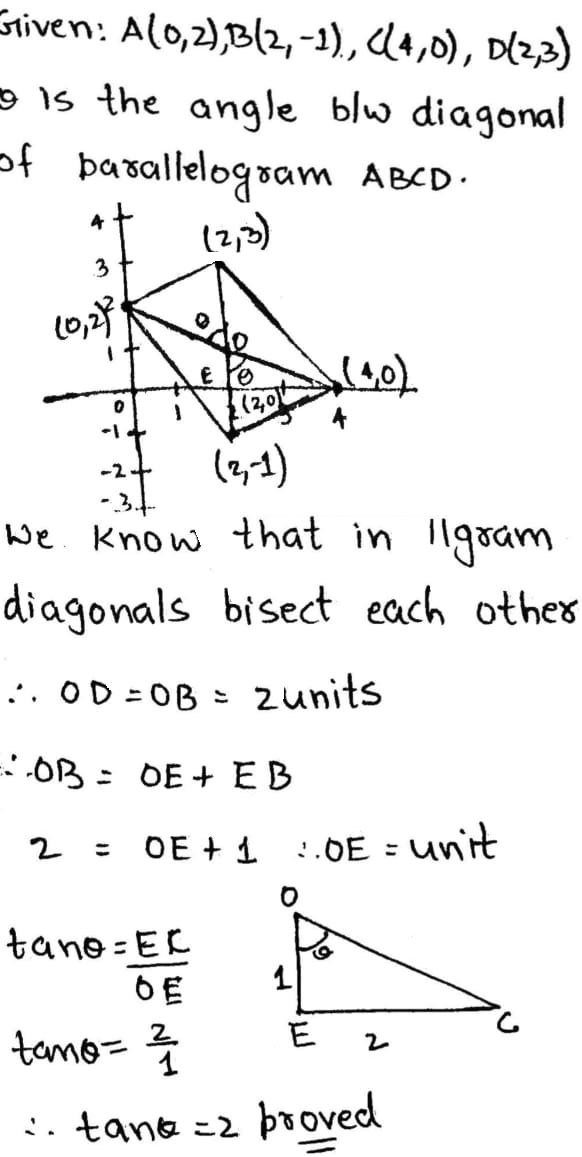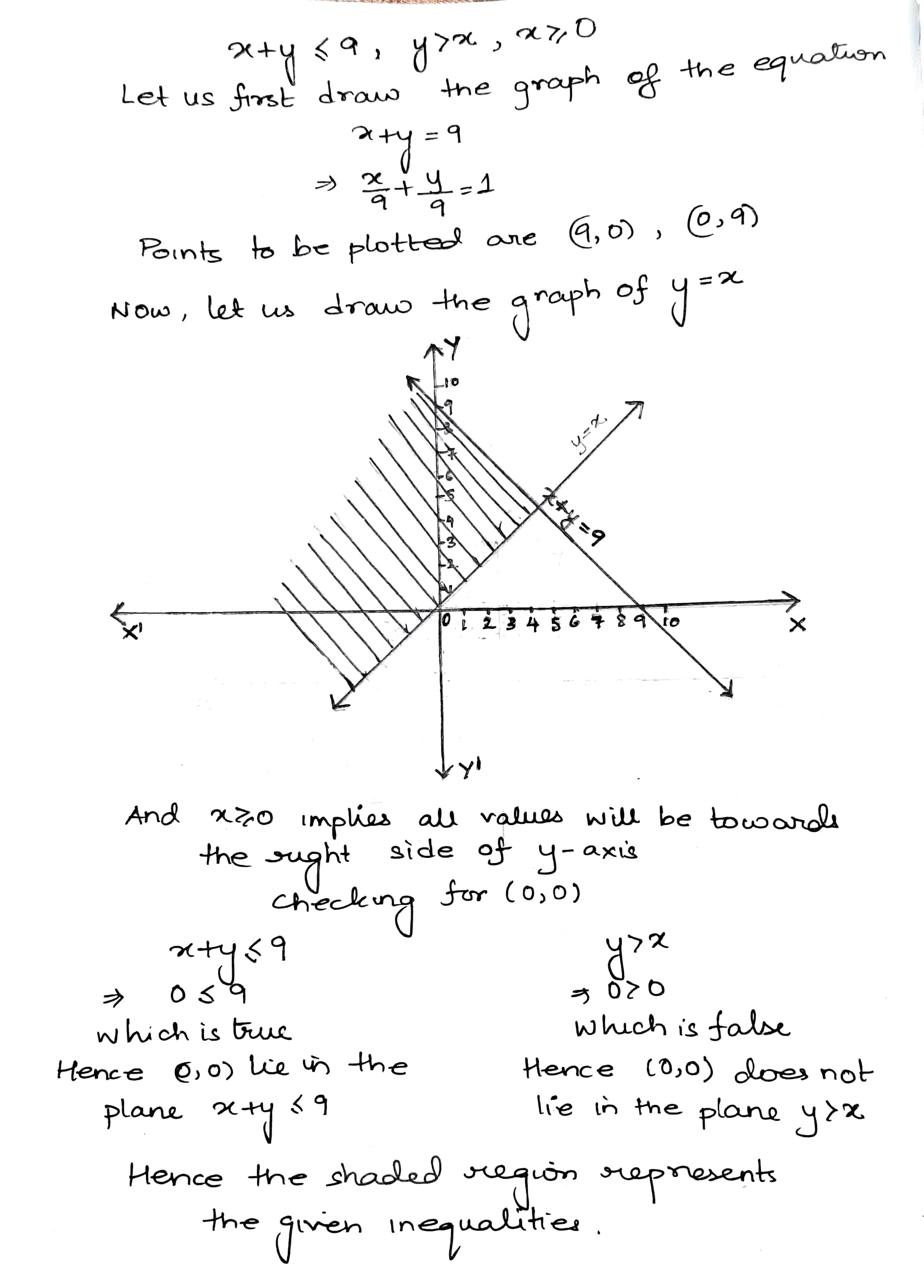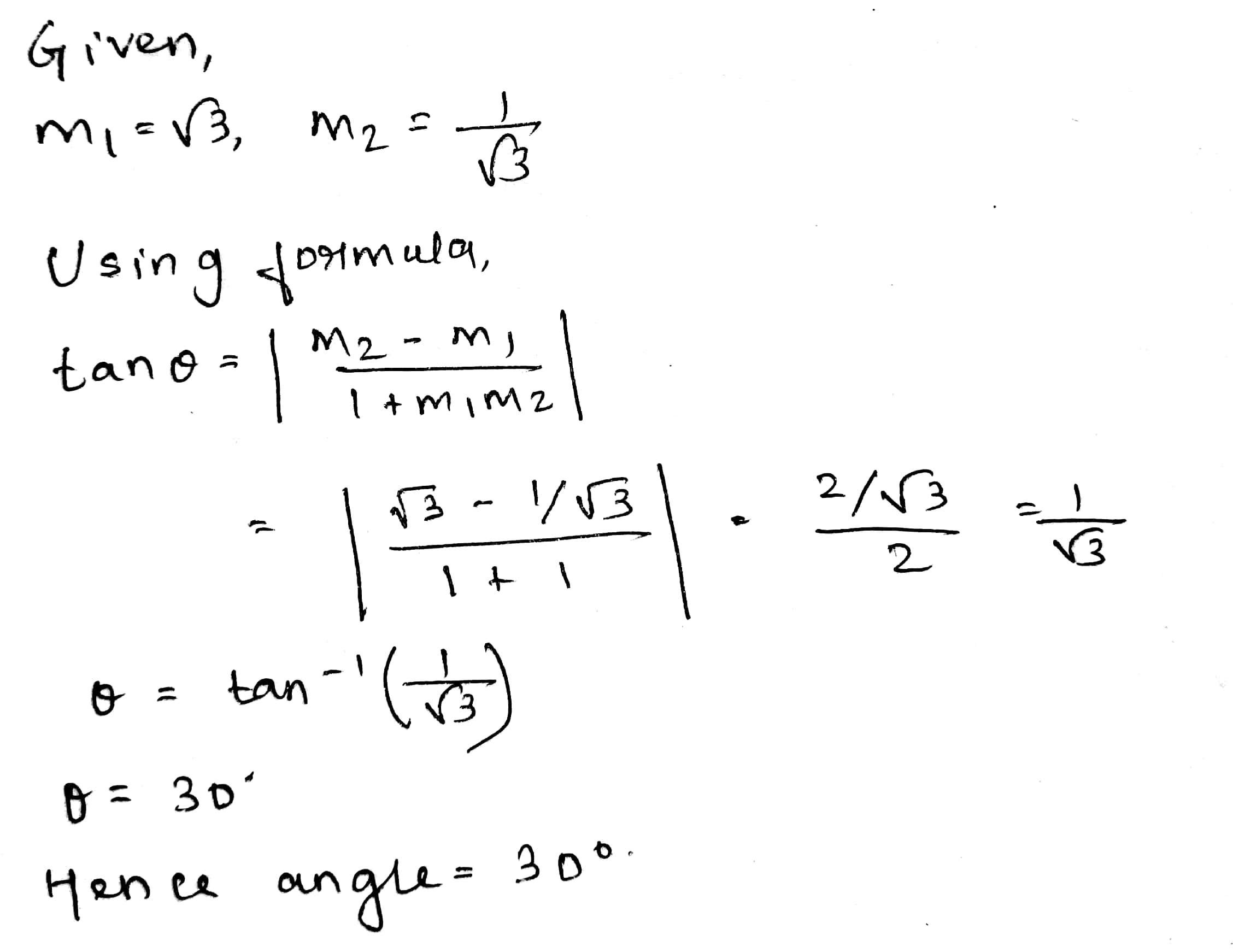Straight Lines - Class 11 Commerce Applied Mathematics - Extra Questions
How many points are there on the x-axis which are at a distance of $$ 2 \sqrt{5}$$ from the point $$(7, 4)$$?
Determine whether the points are vertices of a right triangle $$A(-3, -4)$$, $$B(2, 6)$$ and $$C(-6, 10)$$
The point on the y-axis equidistant from $$(-5, 2)$$ and $$(9, -2)$$ is $$(0,-m)$$, them $$m$$
Find the perimeter of a triangle whose vertices have the coordinates $$(3,10),(5,2)$$ and $$(14,12)$$.
Show that the two parabolas $$ x^2 + 4a (y - 2b - a ) = 0 $$ and $$ y^2 = 4b (x - 2a + b) $$ intersect at right angles at a common end of the latus rectum of each.
Which point on x-axis is equidistant from $$(5,9)$$ and $$(-4,6)$$?
The vertices of a triangle are $$A\left( { - 2,\,2} \right),\,B\left( {4,\,4} \right)\,and\,C\left( {8,\,2} \right).$$ Find the length of the medians to the sides
Find the slope of the line passing through the points $$(3, -2)$$ & $$(7, -2)$$
Find the value of $$x$$ for which the distance between $$p(2, -3)$$ and $$q(x, 5)$$ is $$10$$ units.
Find a point on $$x-axis$$ which is equidistant from $$A(2, -5)$$ and $$(-2, 9)$$.
Find the slope of line which passes through the point (7,11) and (9,15) .
Show that the points $$(3, -2), (1, 0), (-1, -2)$$ and $$(1, -4)$$ are concyclic
Find the point on x-axis which is equidistant from the points (2,-5) and (-2,9).
If the points $$A(1,2), B(-4,3), C(x,2)$$ and $$D(2,3)$$ form parallelogram find the value of $$x$$.
If the point $$A(a,2)$$ is equidistant from the points $$B(8,-2)$$ and $$C(2,-2)$$, the value of $$a$$.
If $$(a,b)$$ is the mid-point of the line segment joining the points $$A\left( {10, - 6} \right),B\left( {k,4} \right)$$ and $$a-2b=18$$,find the value of $$k$$ and the distance AB.
A point P on X-axis is at distance 13 from A(11,12). Find the coordinates of P.
If $$P ( 2 , P )$$ is the mid point of the line segment joining the the points. $$A ( 6 , - 5 )$$ and $$B ( - 2,11 )$$ find the value of $$P .$$
Find the slope of the line whose inclination is $$30^{o}$$
21 - 3(b - 7) = b + 20
Find the inclination of a line whose slope is
(i) $$1$$
(ii) $$-1$$
(iii) $$\sqrt 3 $$
(iv) $$-\sqrt 3 $$
(v) $$\frac{1}{{\sqrt 3 }}$$
Find the slope of the line perpendicular to $$AB$$ if $$A=(0,-5)$$ and $$B=(-2,4)$$.
Find the distance between the following pairs of points:-
$$(2,3),(4,1)$$
Find the angle between the line $$\sqrt {3}x+y+1=0$$ and $$x+1=0$$.
If point $$(x,y)$$ is equidistant from point $$(3,k)$$ and $$(k,3)$$ then find the value of $$k$$ when $$x\neq y$$
Show that the point A(-2,3,5), B(1,2,3) and C(7,0,-1) are collinear .
Find the distance of the point $$P(-6,8)$$ from the origin.
Let $$A (6,4)$$ and $$B(2,12)$$ be two given points. Find the slope of a line perpendicular to $$AB$$.
$$A ( 0,2 ) , B ( 0,5 )$$ be any two points, then the distance between them is _________.
The distance between the two points is $$5.$$ One of them is $$(3, 2)$$ and the ordinate of the second is $$-1$$ , then find sum of its x-coordinate.
Mid-points of the sides AB and AC of $$\Delta ABC$$ are $$(3, 5)$$ and $$(-3, -3)$$, respectively, then find the length of BC.
The vertices of a triangle are A $$(2, 2)$$, B $$(-4, -4)$$, C $$(5, -8)$$. Then, if the length of the median through C is $$\sqrt m$$.Find $$m$$
If P$$(x, y)$$ is a point in the coordinate plane such that locus of P is
Find the angles between the lines $$\displaystyle \sqrt{3}x+y= 1$$ and $$x+\sqrt{3}y= 1$$
Find the slope of a line passing through the points with coordinates $$(-1, 0)$$ and $$(1, 3)$$.
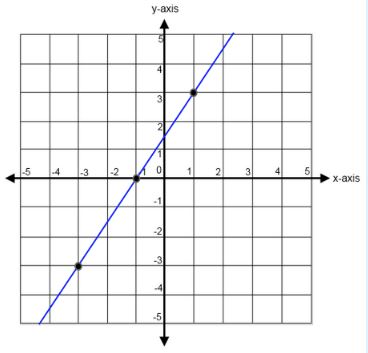
Find the equation of the line that passes through the points $$(-1,0)$$ and $$(-2,4)$$
The distance between A(1, 3) and B(x, 7) isCalculate the possible values of x
A chair is $$5$$ feet from one wall of a room and $$7$$ feet from the wall at a right angle to it. How far is the chair from the intersection of the two walls?
Find the slope of the line with inclination $$60^\circ$$
Prove that the equations to the straight lines passing through the origin which make an angle $$\alpha$$ with the straight line $$ y + x = 0 $$ are given by the equation
$$ x^2 + 2xy \sec 2 \alpha + y^2 = 0 . $$
Prove that the angle between the straight lines joining the origin to the intersection of the straight line $$y = 3x + 2$$ with the curve $$ x^2 + 2xy + 3y^2 + 4x + 8y - 11 = 0 $$ is $$ \tan^{-1} \dfrac {2 \sqrt2}{3}$$
Prove that the points $$(3, 0) (6, 4)$$ and $$(-1, 3)$$ are the vertices of a right angled isosceles triangle.
Find the value of $$k$$ if the angle between St. lines $$4x - y + 7 = 0, kx - 5y - 9 = 0$$ is $$45^{\circ}$$.
Prove that the product of the lengths of the perpendiculars drawn from the points $$(\sqrt{a^2-b^2}, 0)$$ and$$ (-\sqrt{a^2-b^2}, 0)$$ to the line $$\dfrac{x}{a} cos\theta+\dfrac{y}{b}sin\theta= 1$$ is $$b^2$$.
Show that the quadrilateral whose vertices are $$(2,-1),(3,4),(-2,3)$$ and $$(-3,-2)$$ is a rhombus.
Which point on y-axis is equidistant from $$(2,3)$$ and $$(-4,1)$$?
Two vertices of an isosceles triangle are $$(2,0)$$ and $$(2,5)$$. Find the third vertex if the length of the equal sides is $$3$$.
Find the centre of the circle passing through $$(6,-6),(3,-7)$$ and $$(3,3)$$
Name the quadrilateral formed, if any, by the following points and give reasons for your answers:
$$A(-1,-2),B(1,0),C(-1,2),D(-3,0)$$
Prove that the points $$(3,0),(4,5),(-1,4)$$ and $$(-2,-1)$$, form a rhombus. Also, find its area.
If the point $$P(x,y)$$ is equidistant from the points $$A(5,1)$$ and $$B(1,5)$$ prove that $$x=y$$.
Prove that the points $$(3,-2), (4,0), (6,-3)$$ and $$(5,-5)$$ are the vertices of a parallelogram.
If $$A=(2,3)$$, $$B=(-2,3)$$ and $$P$$ moves such that $$|PA-PB|=4$$, then find the locus of $$P$$.
If $$(-4,0)$$ and $$(4,0)$$ are two vertices of an equilateral triangle, find the coordinates of its third vertex.
If $$P(2,-1), Q(3,4), R(-2,3)$$ and $$S(-3,-2)$$ be four points in a plane, show that PQRS is a rhombus but not a square. Find the area of the rhombus.
Prove that the points $$(-2, -1), (1, 0), (4,3)\ and\ (1,2)$$ are the vertices of a parallelo-gram. Is it a rectangle?
If coordinate of two points $$A$$ and $$B$$ are $$(3,4)$$ and $$(5,-2)$$ find coordinates of $$P$$ if $$PA$$=$$PB$$ and area of $$\triangle PAB=10$$
Find the angle between the x-axis and the line joining the point $$(3,-1)$$ and $$(4,-2)$$.
Find the points on the X-axis which are at a distance of $$2\sqrt{5}$$ from the point $$(7,-4)$$. How many such points are there?
If $$R(x, y)$$ is a point on the line segment joining the points $$P(a, b)$$ and $$Q(b, a)$$, the prove that $$x + y = a + b$$.
Show that $$O(0,0),C(a,0),B(a,b),C(0,b)$$ are the vertices of a rectangle. If $$P(x,y) $$ is a point in the coordinates plane, then prove using formula that $$PQ^{2}+PB^{2}=PA^{2}+PC^{2}$$.
In each of the following find the value of $$'k'$$, for which the points are collinear.
$$(7, -2), (5, 1), (3, k)$$.
If the distance between points $$(x,0)$$ and $$(0,3)$$ is $$5$$, what are the values of $$x$$?
Find the point on Y-axis which is equidistant from $$(-6,4)$$ and $$(2,-8)$$.
Prove that the points $$A(-5,4),B(-1,-2)$$ and $$(5,2)$$ the vertices of an isosceles right-angled triangle. Find the coordinates of D, so that ABCD is a square.
If the image of the point $$(2, 1)$$ with respect to a line mirror be $$(5, 2)$$, find the equation of the mirror.
If the points $$(1,1), (-1,-1)$$ and $$(-\sqrt{3},k)$$ are vertices of an equilateral triangle find the value of $$k$$.
Find the point on the x-axis which is equidistant from the points $$(2,-5)$$ and $$(-2,9)$$.
Find the ordinate of point whose abscissa is $$10$$ and which is at a distance of $$10$$ units from the point $$P(2,-3)$$.
Find all possible values of $$a$$ for which the distance between the points $$A(a,-1)$$ and $$B(5,3)$$ is $$5$$ units.
Prove that the points $$A(-2, -1), B(1, 0), C(4, 3)$$ and $$D(1, 2)$$ are the vertices of a parallelogram $$ABCD$$.
Find a point on the x-axis which is equidistant from the points $$(7,6)$$ and $$(3,4)$$.
Find that point on y axis which as equidistant from point $$(6,5)$$ and $$(-4,3)$$
Find the co-ordinates of the point equidistant from the points $$A( - 2, - 3),B( - 1,0)$$ and $$C(7, - 6)$$
Find the cosine of the angle $$A$$ of the triangle with vertices $$A(1, -1), B(6, 11)$$ and $$C(1, 2)$$.
Find the distance between the points A (a,b) and B(b,a) if a-b=4.
If point (x,y) is equidistant from points (7,1) and (3,5) show that y =x-2
Find a point on $$Y$$-axis which is equidistant from $$P(-6,4)$$ and $$Q(2,-8)$$.
Find the equation of a straight line:
with slope $$-1/3$$ and $$y-intercept$$ $$-4$$.
Prove that the points $$(0,\,-1).(2,\,1).(0,\,3)$$ and $$(-2,\,1).$$ are the vertices of square?
Show that the points (12 , 8),(-2 , 6) and (6 , 0), are the vertices of a right angled triangle.
Find the coordinates of point P which divides the line segment joining $$A(-2,-7)$$ and $$ B(6,1)$$ in the ratio $$5:3$$
If $$A$$ is $$( - 1,2,0 ) , B$$ is $$( 1,2,3 )$$ and $$C$$ is $$( 4,2,1 ) ,$$ then prove that $$\Delta A B C$$ is an isosceles right triangle.
How many points are there on the $$x-$$axis whose distance from the point $$(2,3)$$ is less than $$3$$ units ?
If the distances of $${ P }({ x },{ y })$$ from $${ A }(5,1)$$ and $${ B }(-1,5)$$ are equal then, prove that $$3{ x }=2{ y }.$$
If the point $$P(1,2)$$ lies on line segment joining the points $$A(2,4)$$ and $$B(4,8)$$ then find $$\dfrac{{AP}}{{AB}}$$.
Find the angle between the curves given below :
$$y^{2}=4x,\ x^{2}+y^{2}=5$$
evaluate:
$$3x-5y=16;x-3y=8$$
If the slope of a line joining $$A(2,x)B(-3,7)$$ is $$1$$ then find $$x$$.
Find the equation of the set of points such that the sum of the square of its distance from the points (3,4,5) and (-1, 3, -7) is a constant.
Are the points given below collinear? If, state which point lies between the other two $$d(P,Q)=11, d(Q,R)=6.5, d(P,R)=4.5$$
If $$\left(1,x\right)$$ is at $$\sqrt{10}$$ units from $$\left(0,0\right)$$ then find the values of $$x$$
If the points $$A\left(2,0,0\right),\,B\left(4,p,q\right)$$ and $$C\left(1,5,2\right)$$ are collinear,find the values of $$p$$ and $$q$$
If the points $$A\left(1,0,-2\right),\,B\left(2,p,q\right)$$ and $$C\left(-1,5,2\right)$$ are collinear,find the values of $$p$$ and $$q$$
If the points $$A\left(-1,-2,1\right),\,B\left(-2,p,q\right)$$ and $$C\left(1,-2,-1\right)$$ are collinear,find the values of $$p$$ and $$q$$.
If the points $$A\left(4,2,2\right),\,B\left(4,p,q\right)$$ and $$C\left(2,3,3\right)$$ are collinear,find the values of $$p$$ and $$q$$
Find the relation between x and y such that the point (x,y) is equidistnat from the points (7,1) and (3,5)
Given $$A=(3,1)$$ and $$B(0,y-1)$$. Find $$y$$ if $$AB=5$$.
find the distance between A(cos $$\theta $$,Sin$$\theta $$) and B (sin$$\theta $$,-Cos$$\theta $$) using distance formula.find the co-ordinates of the mid point of the line joining the points (3,-10 ) and (6,-8).
If $$A(1, 2), B(-3, 2)$$ and $$C(3, -2)$$ be the vertices of a $$\triangle ABC$$, show that
$$\tan A=2$$
If $$A(1, 2), B(-3, 2)$$ and $$C(3, -2)$$ be the vertices of a $$\triangle ABC$$, show that
$$\tan B=\dfrac{2}{3}$$
A line is of length $$10$$ and one end is at the point $$(2, -3);$$ if the abscissa of the other end be $$10$$, prove that its ordinate must be $$3$$ or $$-9$$.
$$ A $$ is a point on the parabola $$ y^{2}=4 a x . $$The normal at $$ A $$ cuts the parabola again at point $$ B $$.If $$ A B $$ subtends a right angle at the vertex of the parabola. find the slope of $$ A B $$
Find the slope of the line passing through the following pairs of points:
$$(a, -b)$$ and $$(b, -a)$$
Find the slope of the line whose inclination is:
$$72^\circ 30'$$
Find the slope of the line passing through the following pairs of points:
$$(-2, -3)$$ and $$(1, 2)$$
Find the slope of the line whose inclination is:
$$46^\circ$$
Find the slope of the line passing through the following pairs of points:
$$(-4, 0)$$ and origin
Find the inclination of the line whose slope is:
$$1.0875$$
Find the inclination of the line whose slope is:
$$0.7646$$
Without using the distance formula, show that the points $$A (4, 5), B (1, 2), C (4, 3) $$and $$D (7, 6)$$ are the vertices of a parallelogram.
Find the slope of the line parallel to AB if:
$$A = (0, -3)$$ and $$B = (-2, 5)$$
Without using the distance formula, show that the points $$A (4, -2), B (-4, 4)$$ and $$C (10, 6)$$ are the vertices of a right-angled triangle.
Find the slope of the line perpendicular to $$AB$$ if:
$$A = (0, -5)$$ and $$B = (-2, 4)$$
Find the slope of the line parallel to AB if:
$$A = (-2, 4)$$ and $$B = (0, 6)$$
The line passing through $$(0, 2)$$ and $$(-3, -1)$$ is parallel to the line passing through $$(-1, 5)$$ and $$(4, a)$$. Find $$a.$$
Find the slope of the line perpendicular to AB if:
$$A = (3, -2)$$ and $$B = (-1, 2)$$
$$(-2, 4), (4, 8), (10, 7)$$ and $$(11, -5)$$ are the vertices of a quadrilateral. Show that the quadrilateral, obtained on joining the mid-points of its sides, is a parallelogram.
The line passing through $$(-4, -2)$$ and $$(2, -3)$$ is perpendicular to the line passing through $$(a, 5)$$ and $$(2, -1)$$. Find $$a.$$
Determine $$x$$ so that the slope of the line through $$(1, 4)$$ and $$(x, 2)$$ is $$2.$$
Coordinates of $$A$$ are $$(1,1)$$ and of $$A_{n}$$ are $$(n, 2n + 1)$$, $$O$$ is the origin, then match the columns :
$$ A_{1}, A_{2},....A_{n} $$ are points on the line $$y=x$$ lying in the positive quadrant such that $$ OA_{n}=n O \ A_{n-1}, O $$ being the origin . If $$ OA_{1}=1$$ then the coordinates of $$A_{8}$$ are $$ (3a \sqrt 2, 3a \sqrt 2) $$ where $$a$$ is equal to
Find the value of $$x$$ for which the distance between the points $$P(2x,-5)$$ and $$Q(3x,-2)$$ is 5 units.
The x-coordinate of point P is twice its y-coordinate. If P is equidistant from $$Q(2, -3)$$ and $$R(-3, 6)$$ then find the coordinate of P.
Let $$ABC$$,be a triangle such that the coordinates of the vertex $$A$$ are $$(-3,1)$$.Equation of the median through $$B$$ is $$ 2x+y-3=0$$ and equation of the angular bisector of $$C$$ is $$7x-4y-1=0$$.Find the slope of line $$BC$$.
Prove that the points $$(at^2_1, 2at_1)$$, $$(at^2_2, 2at_2)$$ and $$(0, a)$$ will be collinear, if $$t_1t_2=-1$$.
Show that $$A(2, 3), B(4, 5)$$ and $$C(3, 2)$$ can be the vertices of a rectangle. Find the coordinates of the fourth vertex.
Find the points on the x-axis, whose distance from the line $$\dfrac{x}{3}+\dfrac{y}{4}=1$$ are $$4$$ units.
Find the angle between the lines whose slopes are $$(2-\sqrt 3)$$ and $$(2+\sqrt 3)$$.
If $$\theta$$ us the angle between the diagonals of a parallelogram $$ABCD$$ whose vertices are $$A(0, 2), B(2, -1), C(4, 0)$$ and $$D(2, 3)$$. Show that $$\tan \theta=2$$.
If $$\theta$$ is the angle between the lines joining the points $$A(0, 0)$$ and $$B(2, 3)$$, and the points $$C(2, -2)$$ and $$D(3, 5)$$, show that $$\tan \theta=\dfrac{11}{23}$$.
If $$A(1, 2), B(-3, 2)$$ and $$C(3, -2)$$ be the vertices of a $$\triangle ABC$$, show that
$$\tan C=\dfrac{4}{7}$$
Find the angle between the lines whose slopes are $$\sqrt 3$$ and $$\dfrac{1}{\sqrt 3}$$.
Class 11 Commerce Applied Mathematics Extra Questions
- Basics Of Financial Mathematics Extra Questions
- Circles Extra Questions
- Descriptive Statistics Extra Questions
- Differentiation Extra Questions
- Functions Extra Questions
- Limits And Continuity Extra Questions
- Logarithm And Antilogarithm Extra Questions
- Mathematical And Logical Reasoning Extra Questions
- Number Theory Extra Questions
- Numerical Applications Extra Questions
- Permutations And Combinations Extra Questions
- Probability Extra Questions
- Relations Extra Questions
- Sequences And Series Extra Questions
- Set Theory Extra Questions
- Straight Lines Extra Questions
- Tangents And Its Equations Extra Questions
